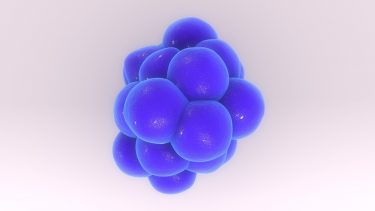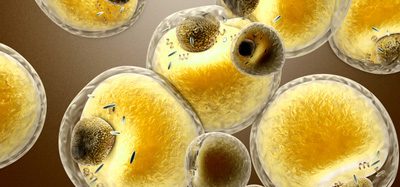Treating cancer patients with cancer anorexia-cachexia syndrome
Posted: 6 January 2022 | Patrick Kendall (Artelo Biosciences) | No comments yet
In this article, Patrick Kendall, Scientific Advisor for Artelo Biosciences, outlines why future treatment of cancer anorexia-cachexia syndrome may lie with drugs in development offering a mechanistic approach.


Introduction
Cachexia is described as a wasting disorder associated with dramatic weight reduction due to the loss of skeletal muscle and body fat. The syndrome affects patients in the later stages of various diseases including congestive heart failure, HIV/AIDS, chronic obstructive pulmonary disease (COPD), kidney failure and importantly in cancer.
Cachexia is intimately associated with anorexia, which is a loss of appetite for food or desire to eat, with a defined reduction of at least five percent of body weight. The combination of cachexia and anorexia is referred to as cancer anorexia-cachexia syndrome (CACS).1
Among hospitalised patients, cancer sufferers present with the highest prevalence of suboptimal dietary intake, with 30 to 50 percent found to be malnourished or at risk of malnutrition.2,3 Cachexia reduces the quality of patients’ lives, compromises therapy and can hasten the end of life. The prevalence increases from 50 percent to more than 80 percent before death and in more than 20 percent of patients, cachexia is noted as the main cause of death.4
Despite its apparent prevalence, CACS remains under-recognised and under-treated in clinical settings, because definitions, diagnostic criteria, classification schemes and licensed therapies have not yet been fully established.5,6 A patient’s nutritional state is usually evaluated with a combination of clinical assessment and anthropometric tests, such as body weight, skin fold thickness and mid-arm circumference, but most clinicians rely mainly on body weight as the major measure of nutritional status, often using usual adult weights as a potentially inappropriate reference.7
Pathophysiology
The causes of CACS are many and various, being broadly divided into those of peripheral or central origin.8 In addition to the disease process itself, treatments, particularly chemotherapy, can markedly contribute to the syndrome.
Peripheral causes may be due to the direct effects of tumours causing dysphagia or interference with gastrointestinal function, tumour-derived substances that reduce appetite (eg, lactate, tryptophan or parathormone-related peptide)9 and tumour-induced inflammation causing cytokine release. Proinflammatory cytokines such as tumour necrosis factor (TNFα), interleukin-1 (IL-1) and interleukin-6 (IL-6) are elevated in many cancers10 and cause sickness behaviour with fatigue, weakness, hyperalgesia and anorexia.11 A related molecule, human growth differentiation factor 15 (GDF15) has also been implicated in cancer cachexia and serum levels of GDF15 correlate with body weight loss in patients with prostate cancer.39
ARTICLE: Telomerase – a universal cancer target for immunotherapeutic vaccines
Chemotherapy commonly causes nausea and vomiting, abdominal cramps and ileus and altered taste perception. Alteration in taste and smell (dysgeusia), is also present in approximately 40 percent of chemotherapy patients.13
Central causes include cancer-related depression and pain with associated changes in central neurotransmitters; notably, the monoamines (5-hydroxytryptamine (5HT) and noradrenaline) and corticotrophin-releasing factor (CRF)12 leading to anorexia.
Treatment
An obvious way to treat anorexia is to improve nutrition, although the evidence supporting the success of this seemingly straightforward approach is lacking.14 Nutritional care and therapy in cancer patients include dietary counselling by dieticians to improve food consumption, oral supplementation with nutritional supplements, enteral nutrition and parenteral nutrition.15 There is no one-size fits all solution and the success of the various approaches varies depending upon the type of cancer and its stage of progression.16,17
Pharmacological approaches
CACS is a difficult syndrome that exacerbates the consequences of many cancers”
To date there are no licensed medicines to treat CACS. However, there are medicines that are used off-license or are currently under clinical development for treating CACS. These therapies can be divided into four major groups dependant on their mode of action.18 These are; appetite stimulants, cytokine modulators, anabolic agents and combination therapies. The progestin megestrol acetate also stands alone outside of these currently, due to its unknown mode of action.
Appetite stimulants
Leptin and ghrelin are two hormones that have important but contradictory influences on energy balance.19 Leptin mediates regulation of energy balance, suppressing food intake and inducing weight loss whilst ghrelin is a fast-acting hormone that controls meal initiation. It is therefore unsurprising that ghrelin-like compounds have been investigated as a potential benefit in CACS therapy.
Anamorelin is an orally available, selective ghrelin receptor agonist. Meta-analysis showed a consistent positive effect of anamorelin on lean body mass and quality of life among cancer patients, although there was no effect on survival.20,21 However, in a number of studies, there was an increased frequency of nausea, hyperglycaemia, skin rash, first degree atrioventricular block and increased liver enzymes.22


Synthetic cannabinoids also hold promise in CACS therapy. ART27.13 (Artelo Biosciences), a peripherally selective, high-affinity, full agonist of CB1 and CB2 receptors, has been demonstrated in a Phase I multiple ascending dose study, to increase body weight. There is a well-known link between peripheral CB1 receptor activation and appetite, food storage and weight gain and given the role of proinflammatory cytokines in CACS, ART27.13’s attenuation of immune function through CB2 activation might well play a part in its anti-anorectic action. A further advantage of this synthetic, peripherally-restricted agent is its lack of any psychoactivity, which is an unwanted side effect of many less selective cannabinoids.
More extensive trials, evaluating the synthetic cannabinoids and the individual components of Cannabis sativa and other modulators of the endocannabinoid signalling system are clearly needed.
Melatonin has been reported to produce increased appetite in advanced lung or gastrointestinal (GI) cancer patients although there were no significant effects on body weight or other end points.26
Cytokine modulators


Anabolic agents
Insulin has been studied, largely on the basis of its anti-lipolytic effects, in advanced GI cancer patients suffering from CACS.32 There were no effects on appetite, body weight or quality of life, although, interestingly, there was some improvement in survival in the insulin-treated group.
Enobosarm (also known as ostarine or MK-2866) is a selective androgen receptor modulator (SARM) developed for the treatment of osteoporosis and muscle wasting, although it is also employed (illegally) as a performance-enhancing drug by some athletes. In a trial of advanced cancer patients with CACS, enobosarm increased lean body mass by 1-1.5kg compared with placebo with some improvement in physical activity measures.33
…there are also some clues from pre-clinical studies that novel or repurposed therapies might be effective”
Megestrol acetate (MA) is a progestin (synthetic progesterone) originally developed for birth control, but also used to treat breast cancer and endometrial cancer. It was approved by the US Food and Drug Administration (FDA) in 1993 for patients with a diagnosis of acquired immunodeficiency syndrome, although its mechanism is unknown. Meta-analysis34 showed that MA stimulated an overall average increase of 2.5kg in body weight in CACS patients, although quality of life was not improved.
Combination therapies
Given the, at best, equivocal benefits of individual pharmacological agents, it is not surprising that there have been a number of attempts to combine compounds in CACS patients. Among these trials, some increased body weight was seen due to a combination of MA, the non-steroidal anti-inflammatory agent meloxicam and the omega-3 fatty acid eicosapentaenoic acid (EPA).35 In another rather complex trial36 which studied various combinations of MA, EPA, L-carnitine and thalidomide, there were some benefits to CACS patients in relation to body weight, resting energy expenditure, appetite and fatigue, although the differences in doses and time intervals make between-group comparisons difficult.
Conclusions
CACS is a difficult syndrome that exacerbates the consequences of many cancers and the heterogeneous nature of the different disease types makes it unsurprising that treatments reversing the muscle and adipose wasting have been challenging to develop. Given the lack of currently licensed therapies in this active field of research, the future of treatment may lie with drugs in development offering a mechanistic approach, such as the benzimidazole derivative ART27.13 and the GDF15 inhibitor Ponsegromab. Additionally, consistency regarding diagnostic criteria is essential within the clinical speciality to be able to effectively compare treatment options and their measured outcomes. In addition to the approaches listed above, there are also some clues from pre-clinical studies that novel or repurposed therapies might be effective. For example, antimyostatin peptides37 have produced significant benefits in mouse models of CACS and the positive effects of beta-adrenergic blockers in cardiac cachexia patients might indicate some potential value in CACS. Equally important will be the necessity of optimising clinical trials with the staging of patients in relation to the severity of their disease, types of anticancer interventional treatment and combining various pharmacological approaches with targeted nutritional and exercise protocols.
About the author
Patrick Kendall received his Medicine degree from the University of Liverpool in 2012. After two years of clinical rotations he moved into the pharmaceutical industry, specialising in the development of new drugs, with a focus on analgesia. Patrick works with Artelo Biosciences through his consulting company, KendallPharma ltd.
References
- Inui A. (2002) Cancer anorexia-cachexia syndrome: current issues in research and management. CA Cancer J Clin. ;52(2):72-91.
- Muscaritoli, M., Corsaro, E., and Molfino, A. (2021). Awareness of Cancer-Related Malnutrition and Its Management: Analysis of the Results from a survey conducted among medical oncologists. Frontiers in oncology, 11, 682999.
- Hébuterne, X., Lemarié, E., Michallet, M., de Montreuil, C. B., et al. (2014). Prevalence of malnutrition and current use of nutrition support in patients with cancer. Journal of parenteral and enteral nutrition, 38(2), 196–204.
- Bruera E. (1997) Anorexia, cachexia and nutrition. Br Med J ;315:1219-1222.
- Wallengren O, Lundholm K, Bosaeus I (2013). Diagnostic criteria of cancer cachexia: relation to quality of life, exercise capacity and survival in unselected palliative care patients. Support Care Cancer; 21: 1569–1577.
- Wiegert, E., de Oliveira, L. C., Calixto-Lima, L., Mota E Silva Lopes, M., and Peres, W. (2020). Cancer cachexia: Comparing diagnostic criteria in patients with incurable cancer. Nutrition (Burbank, Los Angeles County, Calif.), 79-80, 110945.
- Higginson I, Bruera, E. (1996) Practical concepts for clinicians. In: Bruera E, Higginson I, eds. Cachexia-anorexia in cancer patients. Oxford University Press:185-189.
- Ezeoke, C. C., & Morley, J. E. (2015). Pathophysiology of anorexia in the cancer cachexia syndrome. Journal of cachexia, sarcopenia and muscle, 6(4), 287–302.
- Asakawa A, Fujimiya M, Niijima A, Fujino K, Kodama N, et al. (2010)Parathyroid hormone-related protein has an anorexigenic activity via activation of hypothalamic urocortins 2 and 3. Psychoneuroendocrinology; 35:1178–1186.
- Noguchi Y, Yoshikawa T, Matsumoto A, Svaninger G, Gelin J. (1996) Are cytokines possible mediators of cancer cachexia? Surg Today; 26:467–475.
- Myers JS. (2008) Proinflammatory cytokines and sickness behavior: Implications for depression and cancer-related symptoms. Oncol Nurs Forum ;35:802–807.
- Lloyd RB, Nemeroff CB (2011). The role of corticotropin-releasing hormone in the pathophysiology of depression: Therapeutic implications. Curr Top Med Chem; 11:609–617.
- Imai H, Soeda H, Komine K, Otsuka K, Shibata H. (2013) Preliminary estimation of the prevalence of chemotherapy-induced dysgeusia in Japanese patients with cancer. BMC Palliat Care; 12:38.
- Muscaritoli, M., Arends, J., and Aapro, M. (2019). From guidelines to clinical practice: a roadmap for oncologists for nutrition therapy for cancer patients. Therapeutic advances in medical oncology, 11, 1-14.
- Cederholm T, Barazzoni R, Austin P, et al. (2017). ESPEN guidelines on definitions and terminology of clinical nutrition. Clin Nutr; 36: 49–64.
- Mendes NP, Barros TA, Rosa COB, et al. ( 2019). Nutritional screening tools used and validated for cancer patients: a systematic review. Nutr Cancer; 71: 898–907.
- Du H, Liu B, Xie Y, et al. (2017) Comparison of different methods for nutrition assessment in patients with tumors. Oncol Lett ; 14: 165–170.
- Advani, S M, Advani, P G, VonVille, H M, and Jafri, S H. (2018). Pharmacological management of cachexia in adult cancer patients: a systematic review of clinical trials. BMC cancer, 18(1), 1174.
- Klok, M D, Jakobsdottir, S, and Drent, M L. (2007). The role of leptin and ghrelin in the regulation of food intake and body weight in humans: a review. Obesity reviews: 8(1), 21–34.
- Bai Y, Hu Y, Zhao Y, et al. (2017) Anamorelin for cancer anorexia-cachexia syndrome: a systematic review and meta-analysis. Support Care Cancer; 25:1651–9.
- Nishie K, Yamamoto S, Nagata C, et al. (2017) Anamorelin for advanced non-small cell lung cancer with cachexia: systematic review and meta-analysis. Lung Cancer; 112:25–34.
- Garcia JM, Boccia RV, Graham CD, et al.(2015) Anamorelin for patients with cancer cachexia: an integrated analysis of two phase 2, randomised, placebo-controlled, double-blind trials. Lancet Oncol.; 16:108–16.
- Strasser F, Luftner D, Possinger K, et al. (2006). Comparison of orally administered cannabis extract and delta-9-tetrahydrocannabinol in treating patients with cancer-related anorexia-cachexia syndrome: a multicenter, phase III, randomized, double-blind, placebo-controlled clinical trial from the Cannabis-in-Cachexia-study-group. J Clin Oncol.; 24:3394–400.
- Turcott JG, Núñez MRG, Flores-Estrada D, et al. (2018) The effect of nabilone on appetite, nutritional status, and quality of life in lung cancer patients: a randomized, double-blind clinical trial. Support Care Cancer.; 26:3029.
- Bar-Sela, G, Zalman, D, Semenysty, V, and Ballan, E. (2019). The Effects of Dosage-Controlled Cannabis Capsules on Cancer-Related Cachexia and Anorexia Syndrome in Advanced Cancer Patients: Pilot Study. Integrative cancer therapies, 18.
- Del Fabbro E, Dev R, Hui D, et al. (2013). Effects of melatonin on appetite and other symptoms in patients with advanced cancer and cachexia: a double-blind placebo-controlled trial. J Clin Oncol; 31:1271–6.
- Jatoi A, Dakhil SR, Nguyen PL, et al. (2007) A placebo-controlled double blind trial of etanercept for the cancer anorexia/weight loss syndrome. ;110:1396–403.
- Jatoi A, Ritter HL, Dueck A, et al. (2010) A placebo-controlled, double-blind trial of infliximab for cancer-associated weight loss in elderly and/or poor performance non-small cell lung cancer patients (N01C9). Lung Cancer.; 68:234–9.
- Gordon J, Trebble T, Ellis R, et al. (2005).Thalidomide in the treatment of cancer cachexia: a randomised placebo controlled trial. ;54:540–5.
- Yennurajalingam S, Willey JS, Palmer JL, et al. (2012) The role of thalidomide and placebo for the treatment of cancer-related anorexia-cachexia symptoms: results of a double-blind placebo-controlled randomized study. J Palliat Med.; 15:1059–64.
- Mehrzad V, Afshar R, Akbari M. (2016) Pentoxifylline treatment in patients with cancer cachexia: a double-blind, randomized, placebo-controlled clinical trial. Adv Biomed Res.; 5:6.
- Lundholm K, Körner U, Gunnebo L, et al. (2007) Insulin treatment in cancer cachexia: effects on survival, metabolism, and physical functioning. Clin Cancer Res.; 13:2699–706.
- Dobs AS, Boccia RV, Croot CC, et al. (2013). Effects of enobosarm on muscle wasting and physical function in patients with cancer: a double-blind, randomised controlled phase 2 trial. Lancet Oncol.; 14:335–45.
- Ruiz-García, V., López-Briz, E., Carbonell-Sanchis, R., Bort-Martí, S., and Gonzálvez-Perales, J. L. (2018). Megestrol acetate for cachexia-anorexia syndrome. A systematic review. Journal of cachexia, sarcopenia and muscle, 9(3), 444–452.
- Kanat O, Cubukcu E, Avci N, et al. (2013). Comparison of three different treatment modalities in the management of cancer cachexia. Tumori.; 99:229–33.
- Mantovani G, Macciò A, Madeddu C, et al. (2010). Randomized phase III clinical trial of five different arms of treatment in 332 patients with cancer cachexia. ;15:200–11.
- Ojima, C., Noguchi, Y., Miyamoto, T., Saito, Y., Orihashi, H., et al. (2020). Peptide-2 from mouse myostatin precursor protein alleviates muscle wasting in cancer-associated cachexia. Cancer science, 111(8), 2954–2964.
- Clark, A. L., Coats, A., Krum, H., Katus, H. A., Mohacsi, P., et al. (2017). Effect of beta-adrenergic blockade with carvedilol on cachexia in severe chronic heart failure: results from the COPERNICUS trial. Journal of cachexia, sarcopenia and muscle, 8(4), 549–556.
- Lerner, L., Tao, J., Liu, Q., Nicoletti, R., Feng, B. et al. (2016). MAP3K11/GDF15 axis is a critical driver of cancer cachexia. Journal of cachexia, sarcopenia and muscle, 7(4), 467–482. 7.
- Suriben, R., Chen, M., Higbee, J. et al. Antibody-mediated inhibition of GDF15–GFRAL activity reverses cancer cachexia in mice. Nat Med 26, 1264–1270 (2020).
- Study to Compare the Effects of Repeated Doses of an Investigational New Drug and a Placebo on Appetite in Advanced Cancer and Anorexia. Available from: https://clinicaltrials.gov/ct2/results?cond=&term=PF-06946860&cntry=&state=&city=&dist=. [Accessed 1st September 2021].
- Badowski, M. E., & Perez, S. E. (2016). Clinical utility of dronabinol in the treatment of weight loss associated with HIV and AIDS. HIV/AIDS (Auckland), 8, 37–45.
- Andries A, Frystyk J, Flyvbjerg A, Støving RK. Dronabinol in severe, enduring anorexia nervosa: a randomized controlled trial. Int J Eat Disord. 2014 Jan;47(1):18-23.
Related topics
Drug Development, Molecular Targets, Oncology, Therapeutics, Translational Science
Related conditions
AIDS, anorexia, Cachexia, Cancer, Cancer anorexia-cachexia syndrome (CACS), Chronic obstructive pulmonary disease (COPD), congestive heart failure, HIV, kidney failure
Related organisations
Pfizer, US Food and Drug Administration (FDA)








